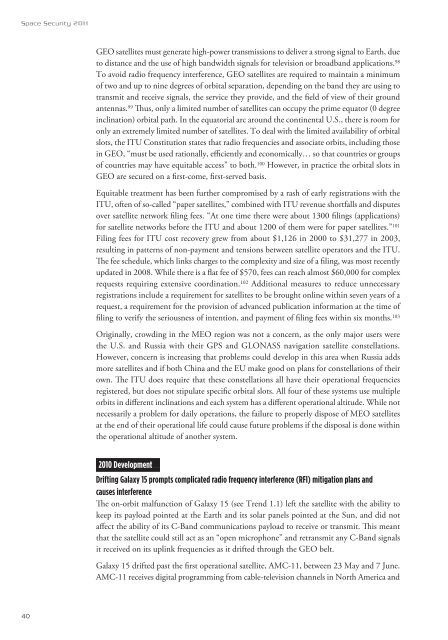Space Security Index
Space Security Index
Space Security Index
Create successful ePaper yourself
Turn your PDF publications into a flip-book with our unique Google optimized e-Paper software.
<strong>Space</strong> <strong>Security</strong> 2011<br />
40<br />
GEO satellites must generate high-power transmissions to deliver a strong signal to Earth, due<br />
to distance and the use of high bandwidth signals for television or broadband applications. 98<br />
To avoid radio frequency interference, GEO satellites are required to maintain a minimum<br />
of two and up to nine degrees of orbital separation, depending on the band they are using to<br />
transmit and receive signals, the service they provide, and the eld of view of their ground<br />
antennas. 99 us, only a limited number of satellites can occupy the prime equator (0 degree<br />
inclination) orbital path. In the equatorial arc around the continental U.S., there is room for<br />
only an extremely limited number of satellites. To deal with the limited availability of orbital<br />
slots, the ITU Constitution states that radio frequencies and associate orbits, including those<br />
in GEO, “must be used rationally, eciently and economically… so that countries or groups<br />
of countries may have equitable access” to both. 100 However, in practice the orbital slots in<br />
GEO are secured on a rst-come, rst-served basis.<br />
Equitable treatment has been further compromised by a rash of early registrations with the<br />
ITU, often of so-called “paper satellites,” combined with ITU revenue shortfalls and disputes<br />
over satellite network ling fees. “At one time there were about 1300 lings (applications)<br />
for satellite networks before the ITU and about 1200 of them were for paper satellites.” 101<br />
Filing fees for ITU cost recovery grew from about $1,126 in 2000 to $31,277 in 2003,<br />
resulting in patterns of non-payment and tensions between satellite operators and the ITU.<br />
e fee schedule, which links charges to the complexity and size of a ling, was most recently<br />
updated in 2008. While there is a at fee of $570, fees can reach almost $60,000 for complex<br />
requests requiring extensive coordination. 102 Additional measures to reduce unnecessary<br />
registrations include a requirement for satellites to be brought online within seven years of a<br />
request, a requirement for the provision of advanced publication information at the time of<br />
ling to verify the seriousness of intention, and payment of ling fees within six months. 103<br />
Originally, crowding in the MEO region was not a concern, as the only major users were<br />
the U.S. and Russia with their GPS and GLONASS navigation satellite constellations.<br />
However, concern is increasing that problems could develop in this area when Russia adds<br />
more satellites and if both China and the EU make good on plans for constellations of their<br />
own. e ITU does require that these constellations all have their operational frequencies<br />
registered, but does not stipulate specic orbital slots. All four of these systems use multiple<br />
orbits in dierent inclinations and each system has a dierent operational altitude. While not<br />
necessarily a problem for daily operations, the failure to properly dispose of MEO satellites<br />
at the end of their operational life could cause future problems if the disposal is done within<br />
the operational altitude of another system.<br />
2010 Development<br />
Drifting Galaxy 15 prompts complicated radio frequency interference (RFI) mitigation plans and<br />
causes interference<br />
e on-orbit malfunction of Galaxy 15 (see Trend 1.1) left the satellite with the ability to<br />
keep its payload pointed at the Earth and its solar panels pointed at the Sun, and did not<br />
aect the ability of its C-Band communications payload to receive or transmit. is meant<br />
that the satellite could still act as an “open microphone” and retransmit any C-Band signals<br />
it received on its uplink frequencies as it drifted through the GEO belt.<br />
Galaxy 15 drifted past the rst operational satellite, AMC-11, between 23 May and 7 June.<br />
AMC-11 receives digital programming from cable-television channels in North America and

















